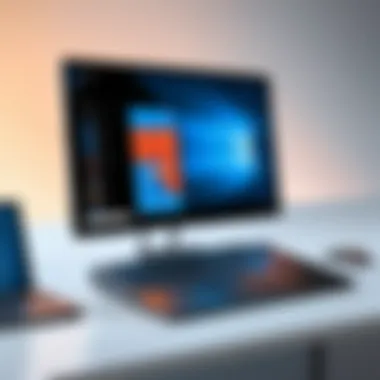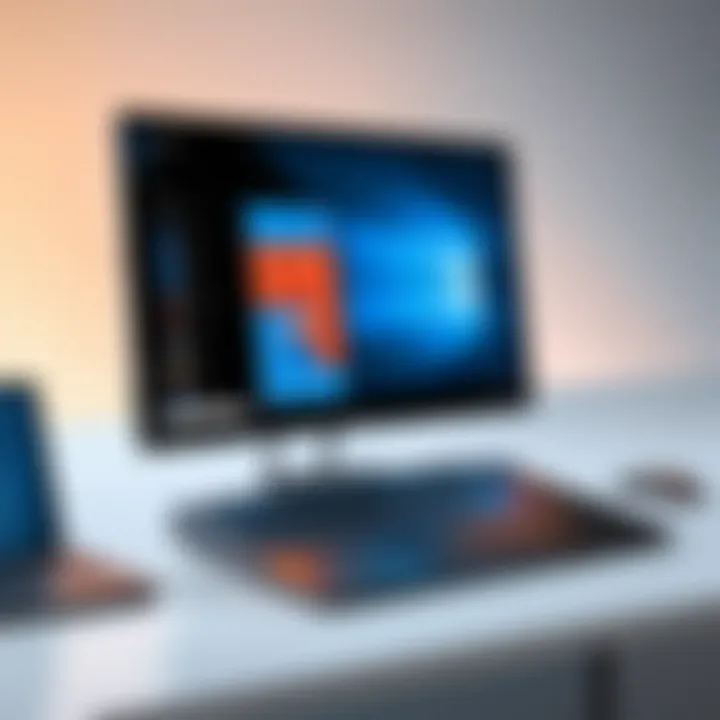Discover the Power of Windows 11 Pro Desktop


Intro
Windows 11 Pro Desktop represents a significant advancement in personal computing. It offers features designed to enhance user productivity and security while maintaining a sleek and modern aesthetic. This article seeks to unravel the complexities of Windows 11 Pro, focusing on its capabilities, improvements, and essential considerations for users. Understanding these elements can help individuals integrate Windows 11 Pro into their digital routines seamlessly.
Key Features
Design and Build Quality
The design of Windows 11 Pro Desktop marks a departure from previous versions. The interface is clean and simplified, featuring rounded corners and a centered Start menu. This promising look facilitates an intuitive experience. The overall aesthetic is modern, representing a refined approach to desktop environments.
In terms of build quality, Windows 11 Pro is optimized for performance. It operates on a variety of devices, from high-end laptops to budget desktops, ensuring that design quality does not compromise functionality. The integration of hardware and software in Windows 11 Pro creates a unified experience that is not only effective but visually pleasing.
Display and Performance
Windows 11 Pro is built to leverage advanced display technologies. Users can expect support for high-resolution screens, making it suitable for a variety of applications ranging from gaming to professional design work. The performance enhancements in Windows 11 Pro ensure that applications run smoother and that multitasking becomes more efficient.
The new Snap Layouts feature enhances productivity. It allows users to organize their windows effortlessly, increasing workflow efficiency. This is particularly beneficial for users managing multiple tasks or applications simultaneously.
Product Specifications
Technical Specifications
Windows 11 Pro Desktop operates on a wide range of specifications that cater to different user needs. Key requirements include:
- CPU: 1 GHz or faster with 2 or more cores on a compatible 64-bit processor
- RAM: 4 GB or more
- Storage: 64 GB or larger storage device
- TPM: Trusted Platform Module version 2.0
- Graphics: DirectX 12 compatible graphics / WDDM 2.x
These specifications allow Windows 11 Pro to perform optimally across various devices, ensuring that users can execute demanding applications with ease.
Compatibility and Connectivity
Compatibility remains a crucial aspect of Windows 11 Pro Desktop. It supports a myriad of devices, from traditional PCs to more modern hardware. Users must also consider connectivity options available within the operating system.
Windows 11 Pro includes improved support for USB-C connections, Bluetooth technology, and various networking standards, ensuring seamless device interaction. Users also benefit from enhanced support for apps and services, expanding the range of functionality available on the desktop environment.
"Windows 11 Pro is designed not just for functionality, but also for a rich user experience. Its features encourage creativity and efficiency."
In summary, Windows 11 Pro Desktop offers remarkable improvements in security, productivity, and user interface. The ongoing evolution seen in this operating system will likely play a pivotal role in shaping personal computing experiences for years to come. Familiarizing yourself with its features is a necessary step towards leveraging its full potential.
Prelims to Windows Pro Desktop
The introduction of Windows 11 Pro marks a significant evolution in the Windows operating system. For tech-savvy individuals and technology enthusiasts, this release offers various enhancements and features that cater to a modern user base. The desktop experience is at the forefront of this update, exhibiting a cleaner aesthetic, better functionality, and improved integrations.
Overview of Windows
Windows 11 is designed to enhance productivity while providing a more intuitive user experience. One of its most notable aspects is the redesigned interface that enhances ease of navigation. The Start menu has been centralized, and the taskbar has become streamlined. The focus on rounded corners and subtle transparency gives it a contemporary feel that appeals to the visually-minded. Furthermore, Windows 11 Pro incorporates dynamic widgets that enable users to access information quickly, thus improving workflow efficiency.
This version also emphasizes seamless connectivity, catering to remote work environments. With the integration of Microsoft Teams directly into the taskbar, collaboration becomes just a click away.
Purpose of the Analysis
The purpose of this analysis is to deepen the understanding of how Windows 11 Pro Desktop transcends past iterations of Windows. By dissecting its features, security, and user interface, readers will be equipped with valuable insights. This exploration will guide users through what makes Windows 11 Pro a compelling choice for both professional and personal use.
Users must also consider compatibility, installation, and productivity tools that Windows 11 Pro provides. By analyzing these aspects, we aim to highlight the advantages that this operating system offers and assist in making informed integration decisions into various technology ecosystems. Understanding these features can elevate one’s capability to utilize the operating system effectively.
Key Features of Windows Pro Desktop
Windows 11 Pro Desktop introduces several key features that enhance user interface, security, and productivity. These features are designed to cater to the needs of tech-savvy users, ensuring their experience is seamless and efficient. Understanding these elements can provide insight into how they benefit everyday usage and facilitate better performance.
The New User Interface
The user interface of Windows 11 Pro is notably different from its predecessors. One significant change is the centered Start menu. This fresh design simplifies navigation and makes it more intuitive for users. Icons are updated for clarity, and there is an increased focus on aesthetics with rounded corners and softer visuals. The taskbar is also adjustable, allowing for greater personalization.
Another important aspect is the integration of Widgets. Users can quickly access relevant information, such as news, weather, and calendar updates without cluttering the desktop. This promotes a cleaner workspace and highlights essential details right at a user’s fingertips. The overall layout encourages multitasking and improves accessibility.
Enhanced Security Features
Windows 11 Pro places a strong emphasis on security. It uses hardware-based protections to safeguard data. Features like Windows Hello and BitLocker encryption offer sophisticated methods for securing devices. Windows Hello streamlines the login process with facial recognition or fingerprint scanning, which is not only convenient but also secure.
Additionally, the OS includes the latest version of Microsoft Defender, which provides robust protection against malware and other threats. This layer of security is particularly crucial in today’s digital landscape, where cyber threats are increasingly sophisticated. The compatibility with TPM 2.0 chips adds another level of security, ensuring that the operating system is more difficult to compromise.
Improved Virtual Desktop Functionality
Virtual desktop capability has seen significant improvement in Windows 11 Pro. This feature allows users to create multiple desktops for different tasks. It is especially useful for professionals who need to separate workspaces for various projects. For example, one can keep office applications on one desktop while using another for personal browsing.
Users can easily switch between these desktops, increasing efficiency and organization. Furthermore, Snap Layouts allow for better window management and productivity. Users can arrange open apps in various layouts, which helps in managing other tasks simultaneously. This level of organization is advantageous for those handling complex projects or requiring extensive multitasking.
"Windows 11 Pro's new features not only enhance usability but also prioritize security in a rapidly evolving tech environment."
In overview, the key features of Windows 11 Pro Desktop are engineered to address the evolving demands of modern users. The new interface, enhanced security measures, and improved virtual desktop functionality create a cohesive environment suitable for both work and personal use.
System Requirements for Windows Pro
Understanding the system requirements for Windows 11 Pro is crucial to ensure a smooth and efficient user experience. This section will explore the specific elements that define whether a computer can run Windows 11 Pro successfully. Knowing these requirements can save potential users from frustration and provide insight into what to look for when upgrading or purchasing new hardware.


Hardware Compatibility
To run Windows 11 Pro, a system must meet specific hardware criteria. Microsoft provided a list of minimum specifications that users should heed before attempting to install the operating system. These requirements include:
- Processor: A compatible 64-bit processor with at least 1 GHz clock speed and two or more cores is needed. This requirement reflects the increase in performance Windows 11 aims to deliver compared to earlier versions.
- RAM: A minimum of 4 GB of RAM is necessary. This allows the system to run efficiently and support multitasking.
- Storage: Windows 11 Pro requires at least 64 GB storage to facilitate installation and operation. It is advisable to have additional space for applications and user data.
- System Firmware: UEFI firmware with Secure Boot capability enhances security in the operating system. This is a major change from the older BIOS system, indicating the shift toward modern security standards.
- TPM: Trusted Platform Module version 2.0 is essential. This security feature is vital for various functionalities in Windows 11, specifically in relation to data protection and secure login methods.
- Graphics Card: A DirectX 12 compatible graphics card or integrated GPU is required to ensure optimal graphical performance.
- Display: At least a 720p display over 9 inches in diagonal size is mandatory, confirming that users have a satisfactory visual experience.
Hardware compatibility is not just about meeting minimum requirements. It reflects the system's ability to deliver the full range of features. Users should consider opting for devices that exceed these specifications to enhance performance and longevity.
Software Prerequisites
In addition to hardware compatibility, certain software prerequisites must be considered for Windows 11 Pro. Foremost, a compatible version of Windows is needed for upgrading. Users currently on older versions, like Windows 10, should ensure they have the latest updates installed to facilitate a smooth transition.
Further software prerequisites include:
- Microsoft Account: Users might need a Microsoft account for certain features. This account helps in synchronization across devices and provides access to the Microsoft Store.
- Internet Connection: An Internet connection is highly recommended for the installation process and to receive updates post-installation. Microsoft emphasizes that some features might require an active connection.
- Device Drivers: It is essential to have updated drivers for all hardware components. This ensures that devices function optimally with Windows 11, providing a seamless user experience.
Preparing your system with the right specifications can unlock the full potential of Windows 11 Pro.
Installation Process
The installation process of Windows 11 Pro is a crucial aspect of this article. It sets the groundwork for the user experience and defines how users adapt to the new environment. Understanding the steps involved in both upgrading from older versions and performing a fresh installation can significantly enhance usability and performance. The installation procedure involves critical decisions about customization and settings that can impact system efficiency.
Upgrade from Previous Versions
Upgrading from a previous version of Windows to Windows 11 Pro involves several key steps. It allows users to retain their files, applications, and settings, as well as experience the improvements made in the latest version. Here are the important stages:
- Preparation: Before starting the upgrade, ensure the current system is compatible. Check the hardware requirements and run the PC Health Check app provided by Microsoft to confirm eligibility. Backing up important data is a wise precaution.
- Starting the Upgrade: Users can initiate the upgrade through Windows Update. In some circumstances, the upgrade assistant might be required. Download this tool from the official Microsoft website.
- Follow Prompts: The upgrade process provides several prompts. Follow these carefully to select preferences related to keeping files and applications. Autoplay settings enable convenience for users upgrading multiple devices.
- Completing the Installation: After going through the prompts, the upgrade process takes place. This can take some time, so patience is essential. The PC will restart automatically, and upon completion, users will be prompted to set preferences like language and region.
By following these specific steps, users can smooth the transition to Windows 11 Pro while retaining their comfort with existing files and applications. It merges efficiency and familiarity into the upgrade experience.
Fresh Installation Steps
The fresh installation of Windows 11 Pro is a more involved process but allows for a clean slate. It is excellent for users wanting to eliminate clutter or start anew. Below are the steps:
- Create Installation Media: First, create a bootable USB drive. This can be done using the Media Creation Tool from the Microsoft website. Users need a USB drive of at least 8GB.
- Set BIOS to Boot from USB: Restart the computer and access BIOS settings. Change the boot order to prioritize the USB drive. This step ensures the installation media is recognized first.
- Begin Installation: Insert the USB drive and reboot the PC. The Windows 11 installer will launch. Choose the 'Install Now' option to start.
- Partitioning: When prompted, select the drive where Windows should be installed. If this is a fresh install, deleting existing partitions may be necessary. Be careful as this will erase all data on selected partitions.
- Follow Instructions: Proceed by following the on-screen instructions. Users need to select language, region, and keyboard preferences.
- Activate Windows: After installation, the system will require activation. Users may input a valid Windows key or choose to do this later.
- Personalization: Finally, users will configure settings such as privacy options and accounts. This ensures the system operates according to personal needs and security preferences.
Completing these procedures equips users with a freshly streamlined system ready for optimal performance. This is critical for ensuring the Windows 11 Pro experience starts off on the right foot.
User Experience
User experience (UX) is a critical component in the evaluation of Windows 11 Pro Desktop. It encompasses how users interact with the system, the intuitiveness of its design, and the overall satisfaction derived from using the operating system. A robust user experience not only facilitates efficiency but enriches the user’s daily interactions with technology. As technology evolves, so does the expectation for seamless and engaging interfaces that can cater to diverse user needs.
Navigating the New Interface
Navigating the new interface in Windows 11 Pro Desktop is a fundamental aspect of user experience. The design has shifted to a more centered taskbar and a streamlined Start menu. This alteration promotes an organized workspace and makes features more accessible. Users can expect to find applications neatly arranged, allowing for quicker access. The desktop environment is designed to reduce clutter, enhancing focus around currently used applications.
The introduction of rounded corners and softer visuals contributes to a modern aesthetic that feels less jarring than previous versions. This new approach aims to reduce cognitive load, helping users engage more effectively with their tasks. Common tasks such as switching between applications or managing virtual desktops have been simplified, thus enhancing overall productivity.
Additionally, gesture-based navigation on touch-enabled devices is improved. Users can smoothly transition between applications, making the experience more fluid, particularly on tablets or convertible laptops.
Customization Options
Customization options in Windows 11 Pro Desktop allow users to tailor their environment to better suit their working styles. The personalization features have been expanded significantly, giving individuals the power to select themes, icons, and layouts. Users can change wallpapers, adjust colors, and even switch between light and dark modes depending on their preferences or ambience.
Moreover, advanced options are available for power users. Settings regarding the taskbar can be modified to pin frequently used applications for quick access. The ability to create and manage multiple desktops lets users compartmentalize tasks, ensuring that personal and professional projects remain organized. This level of customization not only fosters a sense of ownership but also greatly boosts overall productivity.
The new Widgets feature presents a practical addition. It keeps users informed about weather, news, and calendar events without overwhelming their workspace. This aspect can be adjusted to show only relevant information, providing a more personalized experience.
Windows 11 Pro Desktop empowers users with tools to shape their computing environment, enhancing interaction and improving task management.
In summary, focusing on user experience in Windows 11 Pro is essential to harnessing its full potential. The approachable navigation and extensive customization options not only address user preferences but significantly contribute to increased productivity.
Networking and Sharing
Networking and sharing are vital aspects of the Windows 11 Pro Desktop experience. In a world where remote work and collaboration are increasingly common, understanding how to effectively manage networks and share resources is essential. This section delves into the core elements of setting up network connections and highlights file sharing capabilities, showing how these features enhance productivity and ensure seamless communication.
Setting up Network Connections
Establishing a reliable network connection is foundational for any system. Windows 11 Pro provides various options to configure different types of networks, including Wi-Fi and Ethernet. Setting up these connections is straightforward and can be done via the Settings app.
- Accessing Network Settings: To start, navigate to the Settings app by clicking on the Start menu. Select Network & Internet. Here, you can see the status of your connections.
- Choosing the Network Type: Select either Wi-Fi if you’re using a wireless connection or Ethernet for a wired connection. For Wi-Fi, you will see available networks; choose the one you want to connect to and enter the password if prompted. For Ethernet, just plug in the cable to your device and it will connect automatically.
- Network Preferences: You can adjust advanced settings for your connection, such as IP settings and DNS configurations, under Advanced Network Settings. This allows users to customize their connection based on specific requirements.
The ability to set up and manage network connections is integral for optimizing your workflow, especially for professionals who rely on stable internet access for tasks and collaboration.
File Sharing Capabilities
Windows 11 Pro enhances file sharing with features designed for ease and security. These capabilities support collaboration and data exchange among users on the same network.
- Creating Shared Folders: To share files or folders, right-click on the desired item, select Properties, then navigate to the Sharing tab. Click on Share and choose the users you want to share with. You can customize permissions to control their access levels.
- Accessing Shared Resources: Users on the same network can access shared folders via File Explorer. They simply need to go to the Network section in the sidebar and find the computer sharing the file. If set up properly, this makes retrieving shared data simple and effective.
- Security Settings: File sharing includes options for securing shared content. Windows 11 Pro allows users to set up sharing with password protection, adding an essential layer of security. This is crucial for businesses handling sensitive data.
"Effective networking and sharing in Windows 11 Pro are not just about connecting devices, but also about creating an environment conducive to productivity and collaboration."
Applications and Compatibility


The relevance of applications and compatibility in Windows 11 Pro is crucial. In a technological environment where software needs to work seamlessly with hardware, understanding what applications are supported and how older software integrates becomes imperative. A clear grasp of this topic can enhance user experience significantly and ensure that the migration to a new operating system does not disrupt personal or professional workflows.
Supported Applications
Windows 11 Pro supports a vast array of applications designed to harness its unique features. Microsoft has tailored this OS to accommodate popular software tools which are essential in various sectors.
Key supported applications include:
- Microsoft Office Suite: This includes Word, Excel, PowerPoint, and more. They leverage the improved interface and enhanced security features of Windows 11 Pro.
- Adobe Creative Cloud: Applications like Photoshop and Illustrator can take advantage of the performance enhancements found in Windows 11.
- Gaming Software: Windows 11 Pro is optimized for gaming. Games developed for DirectX 12 can perform better and utilize auto-HDR capabilities for a visual boost.
- Video Conferencing Tools: Applications such as Zoom and Microsoft Teams are also supported, ensuring effective communication in increasingly digital workplaces.
- Development Tools: Integrated development environments (IDEs) like Visual Studio function flawlessly, supporting modern programming practices and languages.
Having access to these applications ensures that users can maintain productivity and creativity without interruption. The smooth operation of these essential tools fosters a positive computing experience.
Compatibility with Older Software
One of the significant concerns when transitioning to a new operating system is the compatibility of existing software. Windows 11 Pro has made strides to ensure that many older applications can function without major issues.
It includes support for:
- Compatibility Mode: Users can run older software in compatibility mode, which emulates previous versions of Windows. This feature is vital for legacy applications that still serve a purpose but may not be updated for modern systems.
- Virtualized Environments: Windows 11 Pro can run virtual machines through Hyper-V, allowing older operating systems to be installed alongside Windows 11. This method is beneficial for businesses that rely on legacy systems.
- Review of System Requirements: When attempting to run older software, it's advisable to review the system requirements specified by the developers. Many times, older applications may require specific configurations that Windows 11 can provide.
Understanding how Windows 11 Pro handles older software helps users transition with less friction. They can continue using familiar tools while exploring new features and applications in the updated environment.
The ability to run older software on Windows 11 Pro enhances its overall value, easing concerns about upgrading and allowing for smoother transitions.
Productivity Tools in Windows Pro
Productivity tools in Windows 11 Pro hold significant relevance in today’s fast-paced digital environment. These tools enhance workflow and user efficiency, addressing the needs of tech-savvy individuals and early adopters of technology. The integration of innovative features aids in managing tasks and optimizing time, ultimately impacting overall productivity. With focus sessions and snap layouts, users can effectively organize their activities, streamline multitasking, and achieve better results in their daily operations.
Focus Sessions
Focus sessions are designed to help users concentrate on their tasks without distractions. This feature integrates with Microsoft To Do, allowing users to set specific time blocks dedicated to work or study. The timer countdown visually indicates the period of focused activity, creating a structured environment. One notable aspect is the ability to track productivity trends, which informs users about their performance over time.
Here are some benefits of focus sessions:
- Enhanced concentration: Reduces interruptions and helps maintain focus on essential tasks.
- Goal orientation: By assigning a particular duration for each task, users become more goal-driven.
- Time management: Sets clear boundaries on work periods and breaks, promoting healthier work habits.
"Focus sessions can fundamentally change how we approach our tasks, offering a balance between work and necessary breaks."
Implementing these sessions requires minimal effort and can be adjusted to fit different user preferences. Learning to schedule focus sessions effectively can transform daily routines and enable consistent engagement with priorities.
Snap Layouts and Desktops
Snap layouts and desktops provide a visual organization method for managing multiple applications on the screen. Users can arrange various windows in predefined layouts, allowing for easy switching between tasks. This feature reduces the time spent navigating between apps, especially when dealing with numerous projects simultaneously.
Key aspects of snap layouts include:
- Customizable arrangements: Users can select from various pre-set options or create their own configurations.
- Improved space utilization: Maximizes screen usage, making it easier to manage different documents and applications.
- Easy navigation: Quickly switch between apps and windows without losing context.
Snap desktops take it a step further, letting users create separate desktops for distinct projects or activities. This means that someone could have one desktop for work, another for personal projects, and a third for leisure activities, all accessible with a simple click.
Security Enhancements
The integration of robust security features is crucial in Windows 11 Pro Desktop. As cyber threats continue to evolve, understanding these enhancements can empower users to adopt safer computing practices. Windows 11 Pro offers a multi-layered approach to security, focusing on user identity protection, data encryption, and overall system integrity. This section highlights key elements that enhance security, their benefits, and the considerations for adaptation.
Windows Hello and Biometric Access
Windows Hello provides a modern way to log into devices using biometric data. This feature leverages facial recognition or fingerprint scanning, offering faster access without compromising security. Biometric authentication is more reliable compared to traditional passwords, which can be forgotten or stolen.
- Convenience: Users can sign in with a glance or a touch, making the experience seamless and efficient.
- Security: Biometric data is stored locally, reducing the risk of interception during transmission.
- Compatibility: Many devices support Windows Hello, ensuring a wide range of accessibility for users.
Implementing Windows Hello not only enhances security but also simplifies the user experience. Users should take time to set up this feature during the installation phase, ensuring they register their biometric data effectively.
Enhanced Device Encryption
Device encryption is a vital aspect of data protection in Windows 11 Pro. By encrypting the entire drive, sensitive information remains secure even if the device is lost or stolen. Windows 11 offers both BitLocker and device encryption options.
- BitLocker: A powerful encryption tool that provides encryption for the operating system and all data drives. BitLocker is beneficial for enterprises where data security is a top priority.
- Device Encryption: Automatically encrypts the device if the hardware meets the requirements. It is user-friendly, ensuring basic-level protection for all users.
The benefits of enhanced device encryption include the following:
- Preventing unauthorized access: Only users with the right credentials can access the encrypted data.
- Compliance: Helps organizations comply with data protection regulations by securing sensitive information.
- Peace of mind: Users can feel secure knowing that their data is less vulnerable to theft.
Overall, both Windows Hello and enhanced device encryption contribute significantly to the security landscape of Windows 11 Pro. Adopting these features means that users can focus more on productivity, while these security enhancements work to protect their digital environment.
Support and Updates
In the context of Windows 11 Pro Desktop, the topic of support and updates is pivotal. Software evolves rapidly, and so do user needs and security threats. Regular updates ensure that the operating system remains functional, secure, and current with the latest features. Users might overlook this area, but understanding how Microsoft approaches support and updates can significantly enhance user experience.
Regular Update Schedule
Microsoft has established a consistent update schedule for Windows 11 Pro Desktop. Typically, updates are categorized into three types: feature updates, quality updates, and driver updates.
Feature Updates occur roughly twice a year, introducing new capabilities and improvements. This is when major changes happen, such as new interface elements or productivity tools.


Quality Updates are more frequent, often rolling out once a month. These updates focus on system stability and performance, addressing bugs and vulnerabilities that could be exploited by malicious entities.
Driver Updates ensure that hardware components function optimally with the latest system software.
This structured approach minimizes disruptions while providing critical enhancements to users. Such updates not only improve functionality but also mitigate risks associated with security vulnerabilities. Thus, users are encouraged to enable automatic updates for seamless maintenance.
Accessing Microsoft Support
Accessing support is an essential aspect of the user experience with Windows 11 Pro. Microsoft provides comprehensive resources for users encountering issues. When technical problems arise, knowing how to reach Microsoft Support can save users significant time.
Users can access support through various avenues:
- Support Website: The Microsoft Support website is a hub for articles, guides, and troubleshooting steps. It covers a broad range of topics and provides self-help options.
- Community Forums: Platforms like Microsoft Community and Reddit offer a space for users to engage with one another. This can lead to practical insights and solutions based on collective experiences.
- Support App: Windows 11 Pro includes a built-in support application, allowing users to get assistance directly from their Desktop. This app offers a straightforward way to report issues, ask questions, and receive guidance.
- Phone and Chat: For more urgent matters, contacting Microsoft Support via phone or chat is an option. This provides direct access to representatives who can guide users through complex issues.
Support and updates are integral to ensuring that Windows 11 Pro Desktop remains a powerful tool for productivity. Ensuring users are aware of these resources can significantly improve their experience.
Performance Optimization
Performance optimization is a crucial aspect of using Windows 11 Pro Desktop effectively. As users expect seamless experiences and quick responses from their systems, optimizing performance ensures that you can achieve these results. Optimizing performance can lead to increased productivity, enhanced user satisfaction, and longevity of the device. Factors affecting system performance include hardware, software, and user settings. Understanding how to tweak these elements can lead to significant improvements.
Adjusting Settings for Better Performance
Adjustments to system settings can notably influence the performance of Windows 11 Pro. Users can customize several areas, such as visual effects, power plans, and background applications. These adjustments help in resource management and can prevent system overload.
- Visual Effects: Windows 11 introduces many graphical enhancements. However, they can consume resources. Changing settings to prioritize performance over appearance is advisable. To make alterations:
- Power Plans: The choice of power plan can impact system performance. Users can select a plan that prioritizes performance, especially on desktops. To adjust:
- Background Applications: Many applications run in the background and consume valuable system resources. Controlling which applications are active can improve performance. Users can manage this via Settings > Apps > Startup, turning off unnecessary applications.
- Open the Control Panel.
- Navigate to System and Security > System.
- Click on Advanced system settings.
- Under the Performance section, click on Settings.
- Select Adjust for best performance.
- Go to Settings > System > Power & battery.
- Choose Best performance under the Power mode options.
Tools for Monitoring System Performance
Monitoring system performance is essential for identifying bottlenecks and understanding how different components interact. Windows 11 provides built-in tools as well as third-party applications for this purpose.
- Task Manager: A primary tool for performance monitoring. Users can access it by right-clicking on the taskbar and selecting Task Manager. It shows active processes, their resource usage, and performance graphs.
- Resource Monitor: This tool offers a detailed overview of hardware usage. Users can view CPU, memory, disk, and network utilization. To launch, open Task Manager, navigate to the Performance tab, and then click on Open Resource Monitor.
- Performance Monitor: A more advanced tool designed for extensive tracking and data collection. It allows users to set up performance counters for various elements. It can be accessed by typing Performance Monitor in the start menu.
Using these tools regularly can help users recognize trends and make informed decisions about necessary adjustments.
Regular monitoring is essential. It allows users to catch issues before they escalate.
By adjusting settings and effectively monitoring system performance, Windows 11 Pro users can create a polished operational experience. This not only enhances proficiency but also prolongs the device's lifespan.
Battery Life Considerations
In the modern computing environment, battery life is a critical element that directly impacts user experience. It affects users' mobility, productivity, and ability to complete tasks without interruption. Battery life becomes particularly important for those who rely on laptops and tablets for work or on-the-go activities. Windows 11 Pro brings specific features aimed at enhancing battery performance, providing users with options to extend their usage between charges. Understanding how to maximize battery life not only ensures the longevity of the device's functionality but also contributes to an eco-friendlier technology culture.
Maximizing Battery Efficiency
Maximizing battery efficiency in Windows 11 Pro can lead to significant improvements in daily usage. Here are practical strategies:
- Use Battery Saver Mode: This built-in feature reduces background activity, limits notifications, and lowers screen brightness to extend battery life.
- Adjust Screen Brightness: Lowering the screen brightness can drastically reduce power consumption. Consider automatic adjustments based on ambient light.
- Disable Unused Hardware: Turn off Bluetooth, Wi-Fi, or any peripherals that are not in use. Each active component drains the battery.
- Limit Background Apps: Windows 11 Pro allows users to manage background applications. Reducing the number of apps that run in the background helps in conserving battery.
- Power Plan Settings: Select a power plan suited for battery saving. Windows allows customization based on usage scenarios such as Sleep, Balanced, or High Performance.
Applying these tactics can result in longer operation times, thus less frequent charging.
Battery Settings Overview
Navigating the battery settings in Windows 11 Pro provides users with tools to manage power consumption efficiently. Here are the key components:
- Battery Use by App: This feature shows how much battery each application consumes. It helps identify which apps are drainers and can be adjusted accordingly.
- Battery Notifications: Windows 11 Pro includes settings for notifications regarding battery status. Users can set alerts for low battery conditions, preventing unexpected shutdowns.
- Sleep Settings: Users can configure how long the system waits before entering standby mode. Reducing this time can help save power when devices go unused for a while.
"Understanding and utilizing battery settings can greatly enhance your device’s operational efficiency."
By ensuring that users have a comprehensive grasp of these settings, they can optimize their experience effectively.
The End
The conclusion of this article underscores the significance of Windows 11 Pro Desktop in the modern computing landscape. As technology continues to evolve, operating systems must adapt to cater to the changing needs of users. Windows 11 Pro offers a robust platform that merges enhanced features, security measures, and improved productivity tools to deliver a comprehensive user experience.
Summarizing the Advantages
Windows 11 Pro Desktop brings a variety of advantages that make it stand out:
- User-Friendly Interface: The new user interface is intuitive, facilitating ease of navigation. This is particularly beneficial for less tech-savvy individuals, allowing a smoother transition from older versions.
- Enhanced Security: Features such as Windows Hello and advanced device encryption provide added layers of security, ensuring that user data remains protected.
- Productivity Enhancements: Tools like Focus Sessions and Snap Layouts boost user productivity, making it easier to manage multiple tasks efficiently.
These elements, among others, create a compelling case for adopting Windows 11 Pro Desktop in both personal and professional settings.
Future Prospects of Windows Pro
The future of Windows 11 Pro looks promising. Microsoft is likely to continue its commitment to integrate user feedback into future updates. With advancements in artificial intelligence and cloud computing, Windows 11 Pro could become even more integrated into our daily digital lives. Features such as more advanced virtual desktops and enhanced collaboration tools are possibilities on the horizon.
Moreover, the trend toward remote work means that productivity tools within Windows 11 Pro will need to evolve to meet new demands. As digital collaboration becomes the norm, users can expect Microsoft to focus on improving functionalities that support seamless teamwork.
In summary, Windows 11 Pro Desktop is not just a mere update to its predecessor, but a significant step forward that addresses contemporary challenges while setting the stage for future developments.
Citing Key Sources
Key sources cited within this article include:
- Microsoft Official Documentation: Offers up-to-date information on features, updates, and best practices.
- Wikipedia: Provides a broad overview of Windows 11, covering its history and major developments. en.wikipedia.org
- Britannica: Can be a source for historical insights into the evolution of operating systems.
- Reddit Threads: Users often discuss personal experiences and troubleshooting tips, which can be valuable for understanding real-world issues and solutions. reddit.com
Other resources that can contribute to a comprehensive understanding include tech blogs, forums, and educational videos that break down specific features and usage scenarios. Citing diverse sources ensures that this article remains grounded in a variety of perspectives, catering to the sophisticated reader seeking depth in their knowledge of Windows 11 Pro Desktop.



